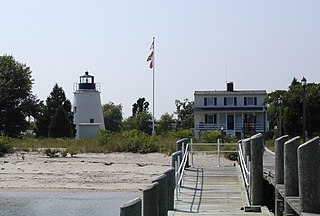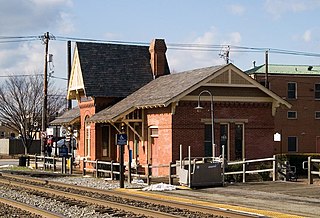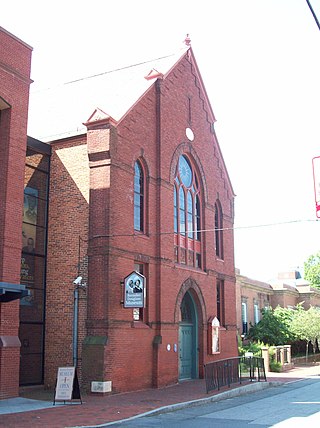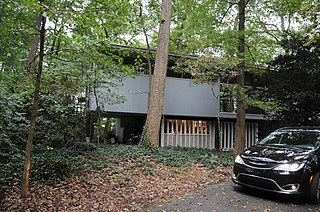
The Piney Point Lighthouse was built in 1836 located at Piney Point on the Potomac River in Maryland just up the river from the mouth of the Chesapeake Bay. The Coast Guard decommissioned it in 1964 and it has since become a museum. It is known as the Lighthouse of Presidents because several early US Presidents visited or stayed on the grounds.

Gaithersburg station is a commuter rail station located on the Metropolitan Subdivision in downtown Gaithersburg, Maryland. It is served by the MARC Brunswick Line service; it was also served by Amtrak from 1971 to 1986. The former Baltimore and Ohio Railroad station building and freight shed, designed by Ephraim Francis Baldwin and built in 1884, are listed on the National Register of Historic Places as Gaithersburg B & O Railroad Station and Freight Shed. They are used as the Gaithersburg Community Museum.

Ashe Cottage, also known as the Ely House, is a historic Carpenter Gothic house in Demopolis, Alabama. It was built in 1832 and expanded and remodeled in the Gothic Revival style in 1858 by William Cincinnatus Ashe, a physician from North Carolina. The cottage is a 1+1⁄2-story wood-frame building, the front elevation features two semi-octagonal gabled front bays with a one-story porch inset between them. The gables and porch are trimmed with bargeboards in a design taken from Samuel Sloan's plan for "An Old English Cottage" in his 1852 publication, The Model Architect. The house is one of only about twenty remaining residential examples of Gothic Revival architecture remaining in the state. Other historic Gothic Revival residences in the area include Waldwic in Gallion and Fairhope Plantation in Uniontown. Ashe Cottage was added to the Alabama Register of Landmarks and Heritage on August 22, 1975, and to the National Register of Historic Places on 19 October 1978.

Saint Joseph College and Mother Seton Shrine are two closely related campuses in Emmitsburg, Maryland, United States. It forms a historic district that was listed on the National Register of Historic Places in 1976.

The Banneker-Douglass Museum, formerly known as Mt. Moriah African Methodist Episcopal Church, is a historic church at Annapolis, Anne Arundel County, Maryland. It was constructed in 1875 and remodeled in 1896. It is a 2+1⁄2-story, gable-front brick church executed in the Gothic Revival style. It served as the meeting hall for the First African Methodist Episcopal Church, originally formed in the 1790s, for nearly 100 years. It was leased to the Maryland Commission on African-American History and Culture, becoming the state's official museum for African-American history and culture. In 1984, a 2+1⁄2-story addition was added when the building opened as the Banneker-Douglass Museum.

Wiley H. Bates High School was a historic black school building in Annapolis, Anne Arundel County, Maryland. It was completed in 1932, and replaced the original Annapolis Colored High School. The school building was named after Wiley H. Bates, a prominent African-American businessman and community leader whose financial donations enabled the school to be built. The name of the school lives on in Wiley H. Bates Middle School, while the original building has been turned into a retirement home combined community center.

Cumberland station is a historic railway station in Cumberland, Allegany County, Maryland. It was built in 1913 as a stop for the Western Maryland Railway (WM). The building was operated as a passenger station until the WM ended service in 1959, and it continued to be used by the railway until 1976. It was subsequently restored and currently serves as a museum and offices, as well as the operating base for a heritage railway.
The Maples is a historic home located at Smithsburg, Washington County, Maryland, United States. It is a two-story, six-bay stone and log dwelling trimmed in black and white. The house features a rather elaborate neoclassical cornice with dentils matching the entrance frontispiece and extending along the entire length of the house. The stone section postdates the log structure and was erected between 1790 and 1810.

Auburn House is a historic home located on the grounds of Towson University in Towson, Baltimore County, Maryland, United States. It was built in 1790 by Charles Ridgely III and stayed in the family until it became part of the Sheppard and Enoch Pratt Hospital property in 1944. Towson University acquired it in 1971.

Mount Harmon is an historic home, located at Earleville, Cecil County, Maryland, United States. It was listed on the National Register of Historic Places in 1974, and is currently open to the public.

St. Francis Xavier Church, or Old Bohemia, is a historic Roman Catholic church located at Warwick, Cecil County, Maryland, United States. It is located on what was once the Jesuit estate known as Bohemia Manor.

The Solomon Arter House is a historic two-story, three-bay log home in Union Mills, Carroll County, Maryland, United States. It was built in about 1810 by Solomon Arter, a member of the Arter family that was prominent in the Pennsylvania German culture of this region. The structure is representative of Pennsylvania German domestic architecture in Carroll County, and is significant for the preservation of its interior stenciling. Also on the property is an 1872 bank barn, hogpen, and 1883 frame Victorian tenant house.

The Englar-Schweigart-Rinehart Farm is a historic home and farm complex located at Westminster, Carroll County, Maryland, United States. It consists of a brick house, a brick smokehouse, a stone springhouse, a frame bank barn, and a frame poultry house. The house is a two-story, five-by-two-bay Flemish bond brick structure painted white, and set on a rubble stone foundation. The house was constructed in 1809 or 1810. The farm is significant for its illustration of how German-Swiss immigrants to Maryland became acculturated to the dominant English culture.

The Robert and Phyllis Scott House is a historic home located at Westminster, Carroll County, Maryland, United States. It is situated atop a ridge on a heavily wooded lot and is a two-story, "butterfly roof", five-bay by two-bay rectangular International Style building set on piers, with several rooms on grade in the center of the house. The house was constructed in 1953–54 to the design of architect Henry Hebbeln of New York.

The Weaver–Fox House is a historic home located at Uniontown, Carroll County, Maryland, United States. It is a simplified Victorian Italianate villa, two stories high with a hip roof. It features two chimneys flanking a rectangular, hipped roof cupola. The house was built during the years 1874 and 1875 as the home of Dr. Jacob J. Weaver, Jr., a country physician.

Trevanion is a historic home located at Uniontown, Carroll County, Maryland, United States. It was listed on the National Register of Historic Places in 1977.

Carroll County Almshouse and Farm, also known as the Carroll County Farm Museum, is a historic farm complex located at Westminster, Carroll County, Maryland. It consists of a complex of 15 buildings including the main house and dependencies. The 30-room brick main house was originally designed and constructed for use as the county almshouse. It is a long, three-story, rectangular structure, nine bays wide at the first- and second-floor levels of both front and rear façades. It features a simple frame cupola sheltering a farm bell. A separate two-story brick building with 14 rooms houses the original summer kitchen, wash room, and baking room, and may have once housed farm and domestic help. Also on the property is a brick, one-story dairy with a pyramidal roof dominated by a pointed finial of exaggerated height with Victorian Gothic "icing" decorating the eaves; a large frame and dressed stone bank barn; and a blacksmith's shop, spring house, smokehouse, ice house, and numerous other sheds and dependencies all used as a part of the working farm museum activities. The original Carroll County Almshouse was founded in 1852 and the Farm Museum was established in 1965.

Medical Hall Historic District is a historic home and national historic district near Churchville, Harford County, Maryland, United States. The home was constructed of stuccoed stone between 1825 and 1840 and is five bays long, two bays wide, and two and a half stories high. The façade features a centrally placed door with sidelights and a rectangular transom subdivided in a radiating pattern. Also on the property is a stone springhouse which 20th century owners have converted into a pumphouse and a stone cottage believed to be a 19th-century tenant house. The property is associated with John Archer (1741–1810), the first man to receive a degree in medicine in America. One of his sons was Congressman, judge of the circuit court, and Chief Justice of Maryland Stevenson Archer (1786–1848).

Uniontown Historic District is a national historic district at Uniontown, Carroll County, Maryland, United States. The district comprises nearly the entirety of Uniontown and contains a remarkably cohesive and well-preserved collection of houses, commercial buildings, churches, and schools reflecting the development of this agricultural village from the turn of the 19th century through the 1930s. It is an example of a linear townscape typical of small settlements in rural north-central Maryland during the 19th century.

Union Bridge station is a historic railway station in Union Bridge, Carroll County, Maryland. It was built in 1902 as a stop for the Western Maryland Railway. It is representative of the rural railway stations constructed during the late 19th and early 20th centuries. The station's two buildings are arranged with their south façades lengthwise fronting the railroad tracks.























